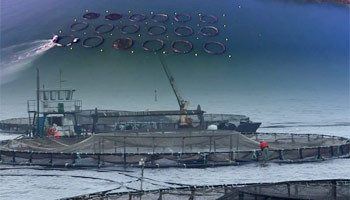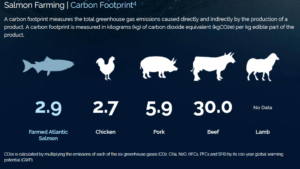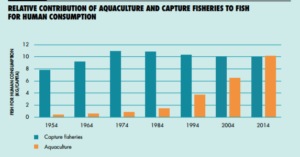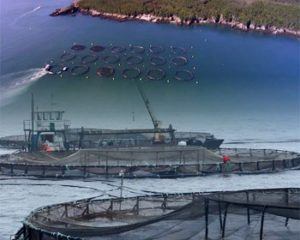Nothing fishy here: opportunities and challenges for aquaculture heating up as fast as the oceans

Cooke Aquaculture is a Canadian based marine salmon farming company (~$1B in revenue) with nascent operations in the US. Climate change presents Cooke, and similar companies in the developed world, with significant opportunity, if critical risks can be mitigated.
Cooke Aquaculture is a Canadian based marine salmon farming company (~$1B in revenue) with nascent operations in the US[i]. Climate change presents Cooke, and similar companies in the developed world, with significant opportunity – as the human population grows, regulation of greenhouse gasses (GHG) in food production increases, and consumer preferences shift to sustainably produced foods, demand for efficiently produced animal protein is likely to increase. Farming salmon utilizes less than 1/10th the GHG’s required to produce beef (see figure 1); innovation in salmon farming practices promises further gains in relative sustainability which could help supercharge the already rapidly growing industry (see figure 2). Furthermore, climate change may aggravate the already critical decline of wild-caught fisheries, leaving aquaculture as the primary source of fish protein for humanity.[ii] [iii]
To capture the growth which could be associated with climate change, Cooke will need to mitigate several critical risks borne of or magnified by climate change: 1) extreme weather events, 2) effects of ocean acidification on feedstock and grown stock, 3) ocean warming and potential for increased incidence of disease.
1) Extreme weather events have the potential to disrupt both Cooke’s growing fish stock through radical short term changes in sea environment and its infrastructure through physical assault. Successful cultivation depends on a stable environment in terms of salinity and temperature – increased incidence and intensity of extreme weather events can throw these factors off, reducing the efficiency of production or in some cases destroying entire stocks. Mitigation strategies include a) thoughtful placement of fish pens (e.g., in protected harbors) b) systems to actively monitor and manage temperature and salinity (e.g., salinity regulators); investing in development of the latter will be critical as supply and effectiveness of the former decreases and requires greater focus from Cooke going forward. Salmon aquaculture involves a significant amount of infrastructure (see figure 3 below). The marine variant practiced by Cooke requires fixed or floating pens connected to an array of feeding and waste pipes, as well as digital feeds. Extreme weather can cause severe damage to this infrastructure (e.g., direct destruction, coastal erosion) resulting in expensive repair, and in some cases losses of fish stocks. Mitigation strategies include (a) above and b) increased resilience of equipment (see next generation pen technology in Figure 4 below). The latter strategy is under-addressed commercially at present and could present opportunity for Cooke to benefit itself, while also producing intellectual property/ products which it could sell to peers.
2) Ocean acidification has the potential to alter the map where Cooke can feasibly operate as it is anathema to stock early in the lifecycle and impairs growth rates throughout the lifecycle. Acidification also has the potential to impact the availability and price of feedstock. Mitigation strategies include a) moving more of the early lifecycle of the fish stock into controlled environments (e.g., growing larvae and juveniles in onshore tanks/ hyper controlled ocean based tanks) and b) careful siting of new fish cultivation operations – for the latter, a greater investment could be made in modeling and anticipating projected effects of acidification on specific areas of the coastline, allowing Cooke to secure the most favorable leaseholds for 5,10,15 etc. years in the future. Another strategy in nascent exploration is c) genetic modification of the salmon to be able to maintain growth even in the face of increased acidification[viii]. Cooke has taken steps to diversify feedstock suppliers, but could explore further diversification/ continue experimentation with utilizing proportionally less actual fish (and more plant products), which has side benefits in reduction of all-in GHG to produce adult fish.
3) Rising water temperatures also have the potential to redraw the salmon cultivation map – production becomes less efficient and then infeasible as a threshold temperature is reached and warming has been linked to a greater incidence and faster spread of disease.[ix] Mitigation strategies include 2a,b&c above as well as development and introduction of tailored antibiotics and targeted distribution systems which ensure the stock is protected but limit potential negative externalities from spread of pharmaceuticals into the broader ocean environment.
Cooke faces a unique set of opportunities and risks – the net effect of climate change on the company and its industry is difficult to predict, but could be managed into the positive with some combination of the mitigation strategies above. Additional steps could be taken. It feels like significant value could be created by Cooke or another actor in developing ocean based production systems which are more resilient, mobile, and controlled, leveraging the latest “Internet of Things” technologies. Increased innovation in the sustainability of fish production seems likely to be rewarded by consumers and regulators – Cooke could double down on becoming one of the most efficient producers of animal protein, creating opportunities for expansion in both the developed and developing world.
[800 words]
[i] Cooke Aquaculture website: http://www.cookeaqua.com/index.php/about-cooke-aquaculture/awards-and-achievements. [Cited 3 November 2016].
[ii] Fisheries and Aquaculture Department. Fisheries and Aquaculture and Climate Change. In: FAO Fisheries and Aquaculture Department [online]. Rome. Updated 28 September 2016. [Cited 3 November 2016]. http://www.fao.org/fishery/climatechange/en
[iii] Cochrane, K.; De Young, C.; Soto, D.; Bahri, T. (eds). Climate change implications for fisheries and aquaculture: overview of current scientific knowledge. FAO Fisheries and Aquaculture Technical Paper. No. 530. Rome, FAO. 2009. 212p.
[iv] Food and Agricultural Organization (FAO) of the United Nations Statistical Division – FAOSTAT. http://faostat3.fao.org/browse/Q/QL/E. Meta analysis by Global Salmon Initiative– http://globalsalmoninitiative.org/sustainability-report/ [Cited 3 November 2016].
[v] FAO 2016. The State of World Fisheries and Aquaculture 2016. Contributing to food security and nutrition for al. Rome. 200p
[vi] Cooke Aquaculture website: http://www.cookeaqua.com/index.php/about-cooke-aquaculture/awards-and-achievements. [Cited 3 November 2016].
[vii] Innovasea website; http://www.innovasea.com/media/. [Cited 3 November 2016].
[viii] National Geographic. http://news.nationalgeographic.com/news/2014/03/140319-salmon-farming-sustainable-aquaculture/
[ix] Cochrane, K.; De Young, C.; Soto, D.; Bahri, T. (eds). Climate change implications for fisheries and aquaculture: overview of current scientific knowledge. FAO Fisheries and Aquaculture Technical Paper. No. 530. Rome, FAO. 2009. 212p.







Really clearly written! Thanks!
In terms of mitigating the effects of ocean acidification, do you think genetically modifying the salmon will turn off customers from the fish? As we saw in the Indigo case, there are still consumers who are wary of GMOs, even if this fear is unfounded. I think the strategies to locate coastline areas least likely to be affected by acidification is a good idea, but I’m sure Cooke’s competitors are also looking into this strategy, which would of course drive up the price of those leases. What do you think?
Also, according to Figure 1, salmon and chicken are on par with each other in terms of carbon footprint. But, fish does not seem to be making up ground compared to chicken, which has grown in popularity in recent years. See this exhibit here: https://www.ncbi.nlm.nih.gov/pmc/articles/PMC3045642/figure/F2/
I know this is TOM, but what marketing efforts do you think need to happen for fish to be more appealing to US consumers?
Great stuff again!
Super interesting article!
One question that I have moving forward about the impact of climate change on Cooke’s operations are rising sea levels and the unpredictability of weather patterns. As we know, storms are becoming much more violent and difficult to predict. While Cooke’s salmon will be in the ocean and should be unaffected by weather, is there any infrastructure in Cooke’s operations and in salmon farming that they will need to protect? Because Cooke’s operations take place in a tumultuous location, they should be wary about protecting their farms.
Interesting read. I think an incremental challenge posed by farm raised fish is the quality of the fish itself. The nutrient composition of wild versus farmed salmon for example can be quite drastic.[1] Farmed salmon is typically much higher in fat, has three times the amount of saturated fat and contains many more calories, mostly from fat. As Paul mentions, if eating fish becomes less healthy, the competitive advantage to eating fish goes down. Not to mention that the taste difference of wild versus farm raised fish can be quite drastic. In my opinion, the flavor is drastically worse in farmed fish. In fact, if I were given a choice, I would pay a premium to eat wild fish over farmed fish. Yet, I understand why farmed fish is a necessary evil in a world where feeding each incremental person becomes more expensive. It just makes me wonder how the flavor of any of our mass-produced, domesticated meats must have tasted many years ago!
[1] Leech, Joe, “Wild vs Farmed Salmon – Can Some Fish be Bad For You?” Authority Nutrition, https://authoritynutrition.com/wild-vs-farmed-salmon/, accessed November 2016.
Really interesting post. I was particularly interested by two aspects. First, I thought the post’s suggestion that the development of fortified aquaculture structures and intellectual property seemed like a tremendous opportunity. NOAA estimates that “aquaculture supplies more than 50 percent of all seafood produced for human consumption,” thus, it appears that there would be a significant market for its products.1 This, however, would depend on Cooke’s capabilities, desire, and access to capital/talent to pursue this route. Second, the post discusses how the impacts of ocean acidification and rising water temperatures may result in fisheries needing to change location. This made me think about the consequences of these weather impacts for local fishing communities and cities as fisheries may need to change locations and/or shift away from wild-caught strategies to adapt to changing conditions. This could have significant impacts on local economies and job prospects.
[1] http://www.nmfs.noaa.gov/aquaculture/faqs/faq_aq_101.html